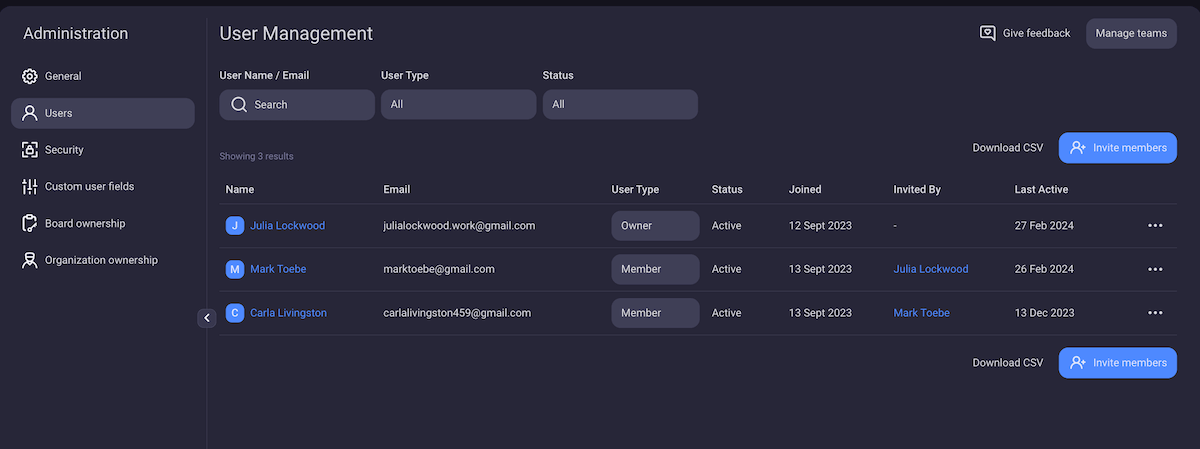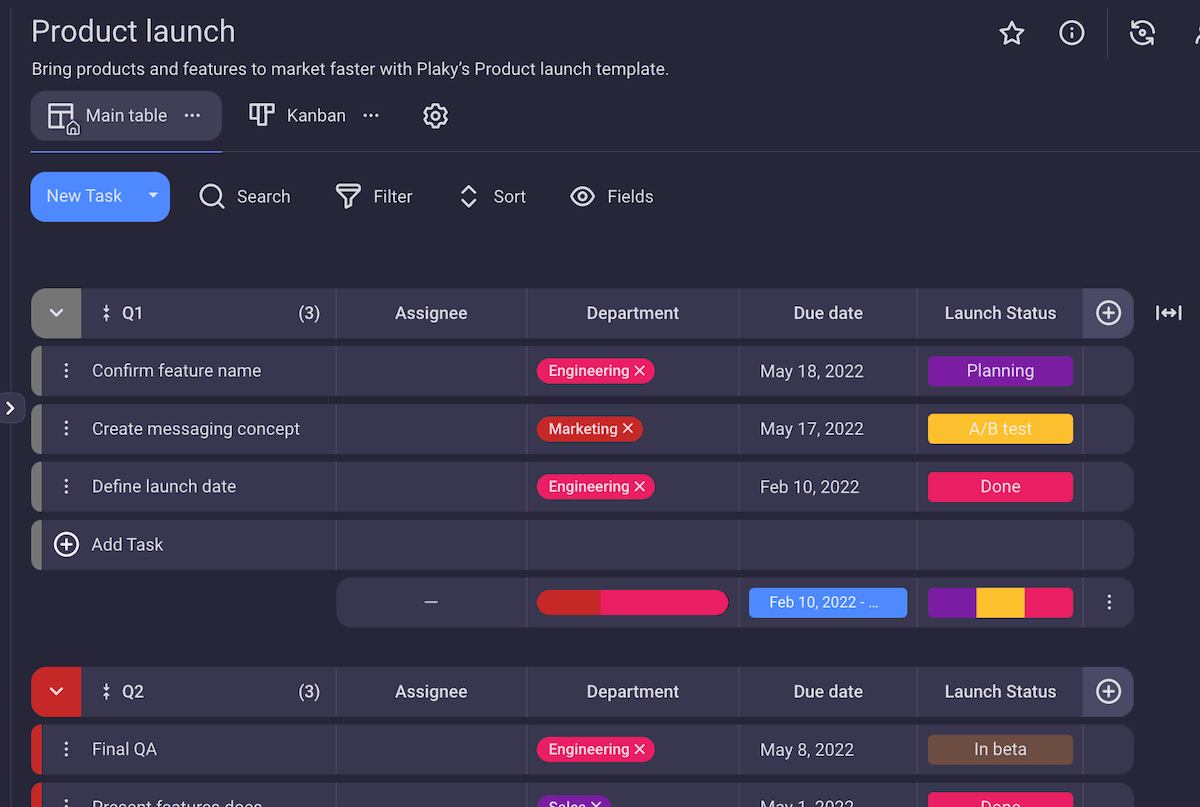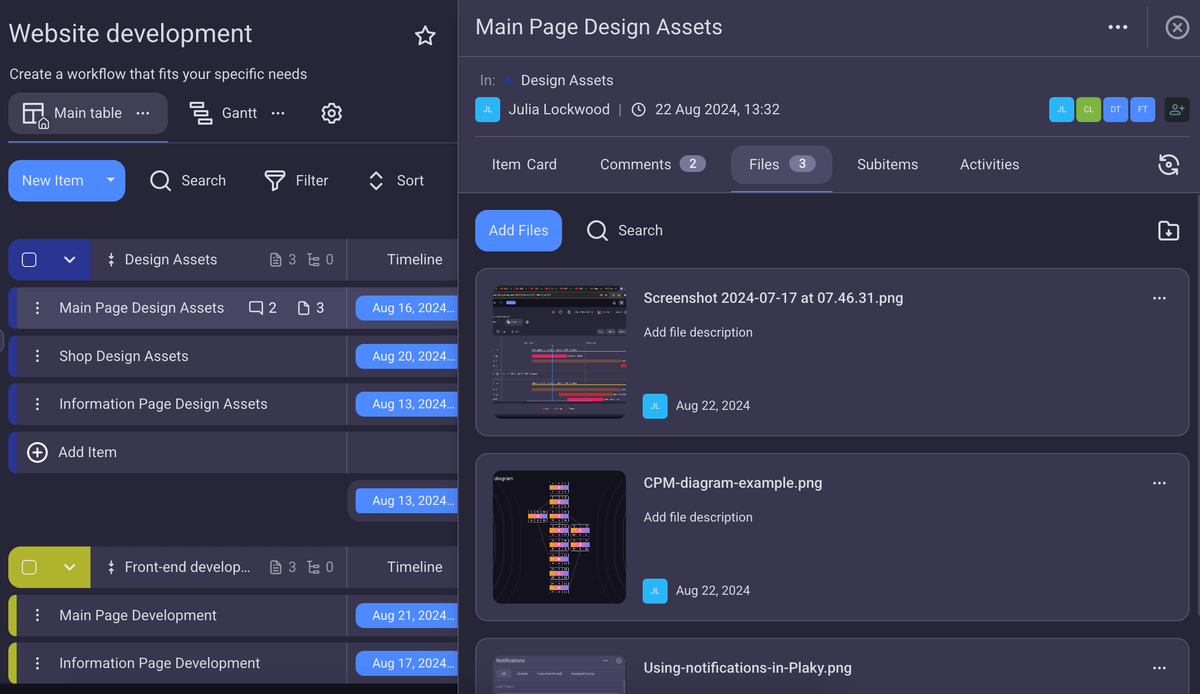Every project has its milestones and goals, and achieving them requires different sets of skills and knowledge. Certain project roles have become standard over time, and some are now present in almost every project, no matter the industry.
Check out the key project roles and their responsibilities and learn how to implement them in your next project.

- Team roles and responsibilities vary from project to project and throughout different industries, so there isn’t a universal set of project roles.
- Project managers are a key figure in every project as they’re responsible for conducting all project phases to completion.
- You can easily set project roles by defining the goals you want to achieve and determining the necessary skill set of your team.
- Project management software with defined user permissions can help greatly in managing different roles.
What is a project team?
A project team refers to a group of people working on a shared project.
Project team members tend to possess diverse skills that are complementary to the skills of other members, creating a coherent group with different roles and responsibilities.
The number of project roles and team members can vary depending on the project type and the company’s industry.
9 key project roles and responsibilities
Project roles vary depending on the type of project and business, so there isn’t a universally accepted list that we can apply to all cases.
Instead, we can describe the 9 key project roles you’re likely to encounter in a project team.
Let’s briefly explain what each role entails.
Project manager
Project managers are in charge of managing projects. They are responsible for planning, organizing, managing, controlling, and reporting on all project phases.
Project managers are professionals who keep the project on schedule and within budget while achieving its objective.
Some of the most important project manager’s responsibilities are:
- Defining the project scope,
- Planning and organizing tasks,
- Managing project resources,
- Negotiating with contractors and suppliers,
- Assessing & managing risks,
- Communicating with the project sponsor and other stakeholders,
- Managing changes,
- Documenting the project’s progress,
- Collecting signatures, and
- Motivating people.
💡 Plaky Pro Tip
Want to become a better project manager? Get some great tips in our guides:
Project sponsor
A project sponsor is usually a person or a group of people at the senior management level.
Project sponsors are accountable for the project’s success and provide guidance and resources to the project team and the project manager. They have 3 key responsibilities:
- Vision — making sure that the project is in line with business goals, strategy, and objectives,
- Project governance — ensuring the project’s launch and execution are adequately conducted, and
- Value and benefits — managing risks and changes while ensuring the project’s quality.
In general, the project sponsor:
- Aligns the project with the overall business strategy, goals, and objectives,
- Ensures the appropriate launch and initiation of the project,
- Approves the project budget and all significant scope changes,
- Makes key decisions for the project,
- Ensures availability of project resources,
- Provides regular feedback to the project team on performance against expectations,
- Evaluates project status and progress, and
- Defines the criteria for project success and how it fits with the overall business.
In short, the project sponsor is involved in a project throughout its whole life cycle.
Project stakeholders
Project stakeholders are people who are interested in a specific project and have an influence on its outcome.
What’s specific about project stakeholders is that:
- They can be internal or external to the project.
- They can be passively or actively involved in a project — or even unaware of their involvement.
- Their priorities can change during the different project phases.
- Their interests can change throughout the project, as well.
- They provide information, as required, to ensure that the project goes as planned and meets the intended goals and deliverables.
There is no universal list of stakeholders to apply to all projects. Also, keep in mind that projects are usually under the influence of external factors that should be accounted for.
Project team members
A project team comprises people with different skills and roles in a project.
Project team members do the following:
- Provide the expertise required to execute project tasks,
- Complete assigned work,
- Collaborate with other team members to achieve project objectives,
- Participate in project team meetings,
- Report issues and status of the project, and
- Document the process.
Project team members can be involved in a project full-time or part-time, depending on the project requirements.
Business analyst
Business analysts work with project team members and stakeholders to establish business needs. They ensure project teams have the tools, technology, and resources required for completing tasks.
A business analyst’s key responsibilities include:
- Planning and monitoring business practices,
- Determining and prioritizing the organization’s operational and technical needs and requirements,
- Understanding business goals, strategies, and needs,
- Verifying that project deliverables meet the requirements,
- Analyzing data, and
- Documenting and analyzing project requirements.
Project coordinator
A project coordinator helps the project manager and team members with administrative tasks related to the project so that the project can keep running smoothly.
The tasks of a project coordinator may include:
- Monitoring the daily project progress and providing updates to project managers or other stakeholders,
- Ordering necessary equipment and office supplies,
- Ensuring team members have the resources they need to complete tasks on time and within the budget,
- Doing tasks related to billing and bookkeeping,
- Organizing invoices, contracts, reports, and other financial documents,
- Managing project-related paperwork,
- Managing deadlines and workflow, and
- Scheduling meetings and appointments.
Project management consultant
Unlike project managers and coordinators, project management consultants are third-party experts who are hired by a company to help with a specific project.
So, they are external PM experts who can help the project manager steer the project in the right direction.
A project management consultant’s responsibilities include:
- Getting familiar with the company and how it works,
- Helping the project manager create a project strategy that works for their needs,
- Introducing innovative solutions to help the project,
- Troubleshooting for potential problems and bottlenecks, and
- Providing expertise in areas the project manager is not familiar with.
Steering committee
The members of a steering committee are usually the company management and senior-level stakeholders.
A steering committee’s role is to:
- Oversee a project from start to finish,
- Provide guidance, and
- Ensure the delivery of the project outputs.
Simply put, a steering committee supports project managers working toward strategic company directions.
The committee is responsible for:
- Setting the strategic direction of projects,
- Providing advice on the budget and regarding changes to the project,
- Identifying the project’s priorities,
- Identifying possible risks,
- Monitoring risks and timelines,
- Prioritizing and reprioritizing project deliverables, and
- Determining the project outcomes and helping to fulfill them.
Subject matter expert
Subject matter experts have in-depth knowledge of a specific subject, business, or technical area. They advise and counsel project teams and help them improve business processes to meet the expected project results.
Subject matter experts usually:
- Communicate with project managers or project stakeholders to suggest best practices or procedures,
- Provide input to stakeholders and project managers to help set project goals and requirements,
- Define procedures or standards (as they are experts who know the right or best way to perform tasks),
- Provide suggestions for procedural improvements,
- Determine performance objectives and specify acceptable performance levels,
- Answer questions regarding the content or strategy of project tasks, and
- Help project managers pinpoint possible risks and fix issues related to their area of expertise.
💡 Plaky Pro Tip
Roles in a team can be very different, and managers need to find ways to actively encourage collaboration. You can find some tips on building your team’s spirit in our guides:
Example of a project team
To explain project team roles further, let’s go over a specific example. We’ll focus on a web development team in a software development company.
A web development project team may have the following professionals on board:
- Project manager,
- Developers,
- QA team,
- UX/UI designers, and
- Business analyst.
The project manager performs the following actions:
- Plans the project,
- Develops a project schedule,
- Assembles a project team,
- Provides a focus for the team,
- Manages the team’s workload, and
- Manages risks and the budget.
Developers work on front-end and back-end development while the QA team ensures the best quality of software by testing it to detect errors.
UX/UI designers are in charge of:
- Collecting and assessing user requirements in collaboration with product managers and engineers, and
- Providing design ideas and designing graphical user interface elements such as a menu, icons, and tabs.
Finally, the business analyst:
- Ensures that requirements are met,
- Acts as a connection between the client, design, and development, and
- Translates the client requests into specifications on how a certain functionality should behave.
💡 Plaky Pro Tip
Starting a web development project? Save time and choose one of Plaky’s pre-made and entirely customizable software development templates:
How to implement project roles in 4 steps
If you’re not sure how to implement different project roles in your team, here’s a quick 4-step guide:
- Identify roles
- Define skills and expectations
- Evaluate workload
- Assign roles
Identify roles
Once you have the project milestones and goals in front of you, start creating a plan of action on how to achieve them.
Each project phase will require certain resources and certain professionals.
For example, launching a new clothing line will require seamstresses, designers, sales managers, and models. Meanwhile, construction projects will need contractors, engineers, and architects.
💡 Plaky Pro Tip
If you’re an architectural PM in need of a trusty PM tool for your projects, check out this list of tools:
Define skills and expectations
When you define the roles you need, you have to determine their responsibilities as well.
Even if you already have an available team, you should define the necessary skills for the upcoming project and what you expect from each role. This way, you can compare right away who’s suitable and who’s missing.
Finding the necessary people before the project starts can save you additional costs later on too. When the project is already underway, lacking experts can cause costly delays that prolong the project and cause shifts in schedule and resource availability.
Save yourself some time by using a skills matrix. We’ve got a free one you could try out:
Get our resource skills matrix template
Evaluate workload
Sometimes, some roles are a key figure only during certain project activities and phases and completely unnecessary for the rest of the project. This is why you should determine who you need and when.
If a role is already present in the company, the responsible person is probably already working on something. You can let them and the other teams know your project’s schedule so that you can coordinate better.
On the other hand, if a role doesn’t exist already, you can launch a search for a freelancer or a permanent employee.
💡 Plaky Pro Tip
Find out how to effectively recruit candidates with the necessary skills and experience in our guide:
Assign roles
Finally, when you’ve determined the roles necessary to complete your project successfully, you can choose the people who will perform them.
Keep in mind that current employees are easier to evaluate as you’re already familiar with their personality and skill set, but new people can also bring a breath of fresh air to the team.
So, when assigning roles, focus on the knowledge and experience necessary to achieve your project’s goals. New employees can contribute to expanding the overall knowledge base and improving team dynamics. Sometimes, even one additional talent can make a great difference.
📖 Some project management methodologies and frameworks, like Scrum, have their own dedicated roles. To learn more about them, as well as other project management terms, check out our Project Management Glossary of Terms.
Manage project roles with Plaky
Wouldn’t it be great to be able to manage entire projects and teams with different roles in one app? Luckily, tools like Plaky can help you organize all your work in one place.
With Plaky, you can easily collaborate with every team member and track how the project progresses. Here’s how!
Permission management
Once you invite your team, you can assign different roles and grant permissions. All team members follow the project progress without compromising information integrity or raising security concerns.
There are 3 user roles in Plaky:
- Admin,
- Member, and
- Viewer (available in Plaky’s paid plans).
Different roles come with different permissions, so you can assign roles based on a person’s actual role on a team. For example, a project manager will be an Admin user, while an external stakeholder might be granted a Viewer role to track the project’s progress.
If you’re running a project that contains sensitive information, Plaky’s Pro plan allows you to create closed spaces or private boards and limit access to members only.
If you go a step further and sign up for Plaky’s Enterprise plan, you can even change board permissions so that only selected people can modify the board’s information and structure.

Task management
For starters, you can save yourself some time and use one of the many project management templates Plaky has to offer. You can also start from scratch and create your own board to fit your project.
Different projects require different structures and — out of multiple board views — you can choose the one that suits you best.
You can also create items that you can assign to one or more team members. Alternatively, every team member can have a dedicated item group with all assigned tasks. That would enable project managers to easily track how work progresses.
Best of all, every item can be as detailed as necessary — just add the fields you need, including:
- Task description,
- Due date,
- Priority, and more.

Seamless collaboration
In Plaky, items can contain not only descriptions but also files. You can attach documents and images before you start working on a task, during the work, or once the task is completed.
This way, every piece of information and every file related to a certain topic will be in one place — so no one will have to waste time looking for it through their inbox.
Another great Plaky feature is the comments section where you can communicate with others in real time. As soon as someone has news or a question, they can tag the right person who will receive a notification immediately. Plus, for quicker updates, you can use emoji reactions!

Managing project roles is a piece of cake when you have the right admin features that Plaky is so meticulous about. So, if you want every team member to track the project’s progress within their role’s permissions — you know where to start.
Not convinced yet? Try Plaky yourself! The 14-day free trial is waiting for you to test the whole feature set.
How we reviewed this post: Our writers & editors monitor the posts and update them when new information becomes available, to keep them fresh and relevant.

